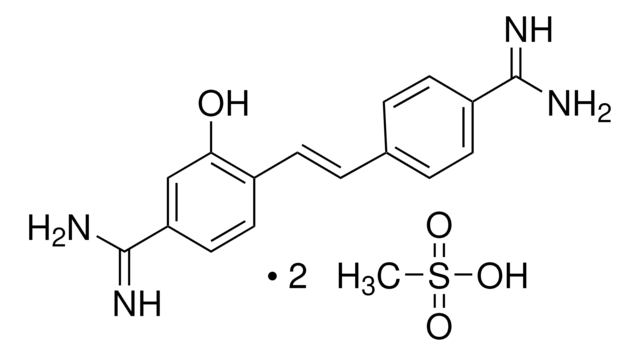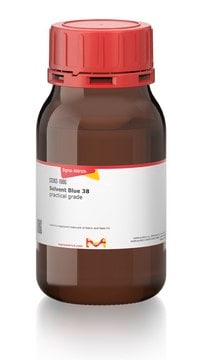AG105
Black Gold II Myelin Staining Kit
Synonym(s):
Myelin stain kit
Sign Into View Organizational & Contract Pricing
All Photos(1)
About This Item
UNSPSC Code:
12161503
eCl@ss:
32161000
NACRES:
NA.41
Recommended Products
manufacturer/tradename
BLACK-GOLD
technique(s)
immunohistochemistry: suitable
shipped in
ambient
General description
Black-Gold II is an aurohalophosphate complex which stains specifically for myelin within the central nervous system. Black-Gold II staining provides high resolution, high contrast, a short histochemical processing time, and high reproducibility. Black-Gold II is a new and improved version of its predecessor, Black-Gold (Cat # AG390). The advantages of Millipore’s Black-Gold II Myelin Staining Kit over Black Gold I are that it is more readily soluble, can be utilized at a higher concentration, produces a more uniform and consistent staining, takes less time to stain, and does not require post-staining intensification procedures.
The use of Black-Gold II is tailored to studies using formalin-fixed, non-solvent processed tissue. The technique stains large myelinated tracts dark red-brown, while the individual myelinated fibers appear black. This novel tracer can be used to localize both normal and pathological myelin. Black-Gold II can demonstrate and characterize specific myelin changes associated with exposure to diverse neurotoxicants including kainic acid, methamphetamine, acrylamide, domoic acid, 3-nitropropionic acid, Fluoro-Gold and isoniazid.
The Black-Gold II Myelin Staining Kit also comes with sodium thiosulfate and cresyl violet. The sodium thiosulfate solution is required for extracting excess Black-Gold II stain. Whereas the cresyl violet is a Nissl stain that colors cell bodies a brilliant bluish hue and is used as a counter stain with Black-Gold II.
Black Gold II Purity: No detectable amount of uncomplexed gold was found.
Black Gold II Illumination: Bright field or dark field.
Black Gold II Solubility: Freely soluble in water, saline, or dilute acids.
The use of Black-Gold II is tailored to studies using formalin-fixed, non-solvent processed tissue. The technique stains large myelinated tracts dark red-brown, while the individual myelinated fibers appear black. This novel tracer can be used to localize both normal and pathological myelin. Black-Gold II can demonstrate and characterize specific myelin changes associated with exposure to diverse neurotoxicants including kainic acid, methamphetamine, acrylamide, domoic acid, 3-nitropropionic acid, Fluoro-Gold and isoniazid.
The Black-Gold II Myelin Staining Kit also comes with sodium thiosulfate and cresyl violet. The sodium thiosulfate solution is required for extracting excess Black-Gold II stain. Whereas the cresyl violet is a Nissl stain that colors cell bodies a brilliant bluish hue and is used as a counter stain with Black-Gold II.
Black Gold II Purity: No detectable amount of uncomplexed gold was found.
Black Gold II Illumination: Bright field or dark field.
Black Gold II Solubility: Freely soluble in water, saline, or dilute acids.
Components
Black-Gold II: 150mg dry powder, yellow in color.
Cresyl Violet Stain: 150mg dry powder, purplish-black in color.
5% Sodium Thiosulfate: 10ml
Cresyl Violet Stain: 150mg dry powder, purplish-black in color.
5% Sodium Thiosulfate: 10ml
Physical form
See Components
Storage and Stability
The kit can be stored at room temperature. Ideally, the Black-Gold II powder should be kept in a desiccator, because of its hygroscopic nature. The dry powder, if unopened and stored properly, is useable for up to one year from date of receipt. Once resuspended the Black-Gold II staining solution should be stored in the dark at 4°C and is good for up to 3 months.
TOXICITY: Although the compound appears to be of low toxicity, it has not been extensively evaluated and therefore routine laboratory caution should be exercised. Not intended for human consumption.
TOXICITY: Although the compound appears to be of low toxicity, it has not been extensively evaluated and therefore routine laboratory caution should be exercised. Not intended for human consumption.
Disclaimer
Unless otherwise stated in our catalog or other company documentation accompanying the product(s), our products are intended for research use only and are not to be used for any other purpose, which includes but is not limited to, unauthorized commercial uses, in vitro diagnostic uses, ex vivo or in vivo therapeutic uses or any type of consumption or application to humans or animals.
Certificates of Analysis (COA)
Search for Certificates of Analysis (COA) by entering the products Lot/Batch Number. Lot and Batch Numbers can be found on a product’s label following the words ‘Lot’ or ‘Batch’.
Already Own This Product?
Find documentation for the products that you have recently purchased in the Document Library.
Customers Also Viewed
Farshid Sepehrband et al.
NMR in biomedicine, 29(3), 293-308 (2016-01-11)
Diffusion-weighted MRI is an important tool for in vivo and non-invasive axon morphometry. The ActiveAx technique utilises an optimised acquisition protocol to infer orientationally invariant indices of axon diameter and density by fitting a model of white matter to the
Introducing Black-Gold II, a highly soluble gold phosphate complex with several unique advantages for the histochemical localization of myelin.
Schmued, Larry, et al.
Brain Research, 1229, 210-217 (2008)
L Schmued et al.
Brain research, 837(1-2), 289-297 (1999-08-06)
A novel haloaurophosphate complex called Black-Gold has been synthesized and applied to localize myelin within the central nervous system. The technique is tailored to studies using formalin fixed non-solvent processed tissue. The technique stains large myelinated tracts dark red-brown, while
Wei Zhen et al.
ASN neuro, 9(4), 1759091417725174-1759091417725174 (2017-08-26)
The cuprizone model is a well-established and investigated paradigm to study demyelination and remyelination in rodents. Cuprizone is usually administrated by mixing in the powdered or pelleted rodent chow. However, since cuprizone is sensitive to the environment and the consumption
Neurotoxic-related changes in tyrosine hydroxylase, microglia, myelin, and the blood-brain barrier in the caudate-putamen from acute methamphetamine exposure.
Bowyer, John F, et al.
Synapse, 62, 193-204 (2008)
Our team of scientists has experience in all areas of research including Life Science, Material Science, Chemical Synthesis, Chromatography, Analytical and many others.
Contact Technical Service











